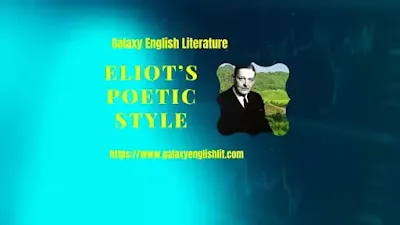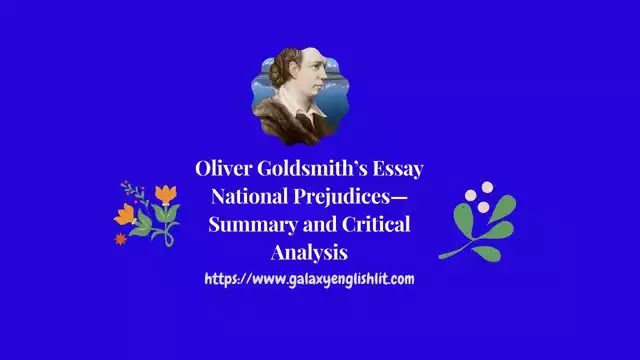Introduction:
Eliot was a great poet. He therefore employed unconventional techniques which are peculiarly his own. Some of the techniques he employed on experimental basis. He dropped those which did not suit and serve his purpose. Eliot emerged on the literary sense of Europe with an extraordinary sensitiveness to modern conditions and equipped with a rare power of analysis and dissection learnt from the progress in the study of the psychological method. His approach to poetry was new and revolutionary.
 |
| Eliot’s Poetic Style |
Eliot felt that existing mode of communication was not sufficient to give expression to the subtleties of the age. But that is not to deny his great indebtedness to tradition. The suggestiveness of the French symbolists, the intellectualism of the metaphysical, the imagery of Baudelaire, and the imagists, the versification of La Forgue and Corbiere —all these have influenced his style in the early stage, but very soon he emerged on his own.
His Impersonal Poetry:
Eliot has no personality to express. He eliminates his personality from his poetic creation. When the poet's mind gets impersonal, his poem is never mere self - expression. Eliot also believes that the poet should also escape from emotion. Under impersonal feeling, Eliot eliminates the wall of separation between the subject and the object, and gets lost in his poetic character, say Prufrock, Gerontion, Tiresias, a hollow man, and others. Placed in different, peculiar, situations and conditions they release their reactions in peculiar images. Eliot's mature poetry is impersonal and of deflated feeling. Exceptions may be found in The Hollow Men and in Four Quartets.
Technique of Compactness and Compressions:
The connecting link, the punctuation and the grammatical conjunction are eliminated for the sake of compression of the subject of matter. He is able to condense great riches in a little room. The subject matter of the poem The Waste Land is so vast that it is covered in four hundred and thirty three times. Moreover, the poet jumps from one concept to another, his transition from one idea to another, is quite sudden. This accounts for his brevity and flexibility. He is keen to omitting what can be left out. The logical links are purposely omitted. Complexity of Subject Matter and Music of Ideas: Eliot deals with the harsh and complex reality of modern urban life. As the subject is complex, his poetry cannot be easy. He poses the problems of the modern civilization, its survival and its system of values and above all man's moral progress. Eliot's words are chosen with reference to their sense and sound. He picks out the vividly memorable phrase. He squeezes words to extract full juice and shades of their meanings. One has to read his poems two or three times in order to fully understand the meaning of his poetry.
Concrete and Precise Images and Symbols:
The romantics make use of symbols as centres of unlimited expansion, with the result there is vagueness and indefiniteness in their poetry. Eliot's images are clear - cut, concrete and precise. He draws his symbols from traditional sources. He does not alter their original significance. He maintains the essential suggestive quality of all symbolism, while limiting the suggestiveness to a clearly defined range. Eliot's approach to symbol and imagery is classical. He retains the suggestiveness which differentiates poetry from prose. His poetry reveals economy of classical school. He has the epigrammatic preciseness, compactness and terseness. In this manner he achieves suggestiveness and elaboration by the help of his symbols and images which have the background of literary tradition.
The Use of Allusions:
Eliot's use of literary allusions is part of his technique of implication. As in the Sweeney poem, he could evoke the majesty of Greek tragedy in the images of Agamemnon and the nightingales ..., so in his many literary echoes (in The Waste Land).... he sets his vision of desolation and spiritual drought in implicit contrast with the visionary world of the elder poets, his masters. Sometimes the contrasts are ironic, as the echoes of Shakespeare's Antony and Cleopatra in the second movement of The Waste Land which describes the boudoir of a neurotic fine lady of the present day, and her rasping quarrel with an almost silent figure, her husband and lover. In Sweeny Among the Nightingales, when Sweeney comes out of the hotel, having rejected the hints of a prostitute, Eliot writes:
“The nightingales are singing near
The convent of the Sacred Heart,
And sang within the bloody wood
When Agamemnon cried aloud
And let their liquid sifting fall
To stain the stiff dishonoured shroud.”
Avoiding Connectives, Punctuation etc.:
Consequently Eliot's poem began to run with brisk movement, pausing only at colons and full stops. As a poet, he has left out all that he considered inessential. For instance, all the five sections of The Waste Land go start to finish, without any explanatory matter:
“April is the crullest month, breeding
Lilacs out of the dead land, mixing
Memory and desire, stirring
Dull roots with spring rain
Winter kept us warm, covering
Earth in forgetful snow, feeding
A little life with dried tubors.”
Here the first four lines have been spoken by Tiresias whereas the last three, by Marie, a German Princess. There is no explanatory matter between the two speeches. Commas have been employed for the sake of musical rhythms. In a case where likes to create brisk, non - stop, rhythms, he avoids connectives, punctuation mark and explanatory matter altogether. In The Hollow Men IV, he puts a full - stop after sixteen lines.
His Versification:
Eliot was a great experimenter with verse forms. In his long poetic career, he experimented with over forty metres. The traditional iambic metre was made more flexible by him. T. S. Eliot made use of this metre to express the changing tempo of the modern mind, feelings with the soul, the jarring sounds and incoherent noises of urban life. This metre enabled him to express the clash of opposite thoughts. The Waste Land shows the culmination of Eliot's skill in the handling of traditional metres. The poet has made use of the heroic line which has been handled very successfully. He is performing miracles of beauty and sweetness by means of using traditional forms. According to Helen Gardener, the form of Four Quartets emerged out of The Waste Land. So it is no denying the fact that the form of The Waste Land is par excellent. This form was further developed by the poet in Four Quartets. Eliot has used iambic lines modified with trochaic, anapaestic of dactylic, rhythms here and there. He has also employed lines of unequal lengths. He has given up rhyme, with the conviction that rhyme removed, much ethereal music leaps up from the world. Yet he has employed occasional rhyme for a sudden tightening up, for a cumulative insistence, or for and abrupt change of mood. In Prufrock (1917), he has employed irregular verse of irregular stanzas. In Poems 1920 he has used tight quatrains.





